- NEW! 88 HP 900 TWIN EFI ENGINE Specifically built for an extreme performance Side x Side. The Polaris ProStar™ 900 features industry-leading 88 HP, Dual OverHead Cams (DOHC), large valves for high RPM power and 180 degree crank shaft for balanced performance. This delivers fast throttle response, groundbreaking power and revolutionary acceleration.
- XTREME PERFORMANCE POWER to WEIGHT It’s 29% quicker than the next closest competitor. This revolutionary acceleration is made possible by the 88 HP lightweight engine and total vehicle weight combined with big-time power to the ground. The result is loads of torque to all four wheels and unsurpassed off-road acceleration
- NEW! LIGHTWEIGHT, COMPACT TRANSMISSION Specifically built to optimize power of the new Polaris ProStar™ 900 engine, its high-torque capacity delivers superior performance and handling. This means more power to the ground, less driveline noise and lighter weight. The innovative lightweight design features a helical cut final drive with optimized gear geometry to maximize efficiency.
- NEW! 3-LINK TRAILING ARM LONG TRAVEL IRS We designed the all-new 3-Link Trailing Arm IRS to handle all that massive power and keep the ride smooth. The 3-Link design consists of two extra-long radius rods and a far forward-connecting trailing arm resulting in a strong yet lightweight system.
- NEW! NEVER-BEFORE-SEEN TRAVEL & GROUND CLEARANCE The new 3-Link Trailing Arm IRS, paired with premium Fox Shocks, creates a monstrous 14″ of terrain-absorbing rear travel. Match that with an astounding 13.5″ of front travel and 13″ of ground clearance and no comparison is required. Hands down, RANGER RZR XP™ owns the desert, the dunes and any wide open space.
- PREMIUM SHOCKS WITH FRONT DUAL A-ARM SUSPENSION Standard on all 4 corners are premium Fox Podium X 2.0 Shocks with piggy-back reservoirs – compression and preload adjustable. Pair that with Dual-A-Arm front suspension with 13.5″ of travel and it soaks up the rough stuff and delivers a smooth, precise ride every time.
- LOW CENTER OF GRAVITY Even with 13″ of ground clearance, RANGER RZR XP™ still has a class-leading low center of gravity for the ultimate ride through rough terrain. Its patented engine-behind-the-seat design and rear weight bias deliver extreme, razor-sharp agility and performance
- NEW! UNMATCHED CORNERING AND STRAIGHT-AWAY AGILITY The new 3-Link race inspired rear suspension maximizes traction and power in corners and straightaways. Tires lean into the corner through the suspension travel, planting more tire surface on the ground to create positive tire camber for more control. The trailing arms also minimize wheel scrub for superior straightaway power, helping you stay true to your line.
- ON-DEMAND TRUE ALL-WHEEL DRIVE True AWD gives you the ultimate grip to put that 88 HP to work in the corners, whoops and loose terrain. It’s the easiest to use and fastest responding on-demand system, automatically engaging all four wheels when you need more forward traction and reverting back to 2WD when you don’t. This means less wear and tear, easier steering, and maximizes power when you need it most
With so many premium features, the 2011 Polaris RANGER RZR XP™ 900 is not just at the head of its class, it’s in a class by itself. Key features are:
- Polaris ProStar™ 900 DOHC Twin EFI Engine
- NEW! 3-Link Trailing Arm IRS with 14″ of Travel
- On-Demand True All-Wheel Drive
- NEW! Exclusive ITP® Tires Standard Exclusive ITP 900 XCT TIRES – Standard on RANGER RZR XP™, the unique directional lug pattern provides exceptional cornering and straight-line traction capabilities
- EXCLUSIVE FACTORY LED HEADLIGHTS NEW! Industry first factory LED headlights shine a high-intensity bright white beam to turn night into day, and throw light forward far beyond conventional halogens
- NEW! GLOVE BOX STORAGE Passenger-side glove box has 3 gallons of space for convenient, water-resistant storage.
- COMFORTABLE ERGONOMICS Everyone rides in comfort, thanks to adjustable and interchangeable bucket seats, plus the adjustable front passenger handrail and full rear passenger handrail. Comfortable driver operation is enhanced by tilt steering with the highest range of motion (10)
- NEW! 3-LINK TRAILING ARM LONG TRAVEL IRS We designed the all-new 3-Link Trailing Arm IRS to handle all that massive power and keep the ride smooth. The 3-Link design consists of two extra-long radius rods and a far forward-connecting trailing arm resulting in a strong yet lightweight system.
| Engine Type | 4-Stroke DOHC Twin Cylinder |
| Displacement | 875cc |
| Fuel System | Electronic Fuel Injection |
| Cooling | Liquid |
| Transmission/Final Drive | Automatic PVT P/R/N/L/H; Shaft |
| Drive System | On-Demand True AWD/2WD |
| Front Suspension | Dual A-Arm Fox Podium X 2.0 (comp adjust/res.) 13.5″ (34.3 cm) Travel |
| Rear Suspension | Trailing Arm Fox Podium X 2.0 (comp adjust/res.) 14″ (35.6 cm) Travel |
| Front/Rear Brakes | 4-Wheel Hydraulic Disc with Dual-Bore Front Calipers |
| Parking Brake | Park in Transmission |
| Front Tires / Model | 27 x 9-12; ITP 900 XCT |
| Rear Tires / Model | 27 x 11-12; ITP 900 XCT |
| Wheels | Cast Aluminum |
| Wheelbase | 81.4″ (206.8 cm) |
| Dry Weight | 1,190 lbs. (539.8 kg) |
| Overall Vehicle Size (LxWxH) | 108.4″ x 64″ x 73″ (275.3 x 162.6 x 185.4 cm) |
| Ground Clearance | 13″ (33.0 cm) |
| Fuel Capacity | 7.25 gal (27.4 L) |
| Bed Box Dimensions (LxWxH) | 23 x 38 x 10″ (58.4 x 96.5 x 25.4 cm) |
| Box Capacity | N.A./300 lb (136.1 kg) |
| Payload Capacity | 740 lb (335.6 kg) |
| Hitch Towing Rating | N.A. |
| Hitch/Type | None |
| Cargo System | Lock & Ride |
| Lighting | White LED, High/Low |
| Electronic Power Steering | Not Equipped |
| Instrumentation | Digital Gauge, Speedometer, Odometer, Tachometer, Tripmeter, Hour Meter, Clock, Gear Indicator, Fuel Gauge, Hi-Temp/Low-Batt Lights, Coolant Temp, DC Outlet |

If you look at the recent history of Polaris starting with the launch of the original Ranger RZR, this is not a company that follows. While Arctic Cat and Can-Am came to market with high-powered models that combine sport and utility, Polaris didn’t give utility a second thought with its latest offering. In fact, the RZR XP doesn’t even have a tow hitch! The way Polaris tells it, every element was designed with sport performance in mind. In other words, you won’t be hauling logs and helping out at the worksite in this machine. The Heart of the Beast Powering the RZR XP is the ProStar 900, a purpose-built 875cc, 4-stroke, fuel injected, DOHC Twin cylinder engine. It may not seem like a huge upgrade from the 760cc mill powering the rest of the RZR family, but the difference is enormous.
When we first arrived at the staging site for our test ride, Polaris had the engines humming in a fleet of the new RZR XPs. The sound emanating from the powerplant sent shivers down our spines. It’s higher pitched than anything we’ve previously heard from a side-by-side and that’s partly due to its higher revs. The ProStar 900 revs 2000 rpms higher than the other RZR engines. It doesn’t exactly compare with a sport motorcycle, but it’s certainly moving in that direction.
A more robust engine doesn’t mean much if it can’t breathe, so Polaris outfitted the RZR XP with a much bigger air filter – 90 percent more surface area than the original RZR. Helping to cool all that air is a new larger radiator.
The power numbers produced by the ProStar 900 are staggering. At the crank the engine produces 88 horsepower. Press down on the throttle and you’re treated to neck-snapping acceleration and a top speed of 73 mph!
To better deal with added stresses of the powerful new engine, Polaris engineers also had to redesign the transmission. Polaris eliminated all right angle drives to the rear axle, which results in less friction and improved power delivery to the rear wheels. We also noticed that operation of the new transmission, which is lighter than on the original RZR, is much quieter.
Finally, to help keep the RZR XP running smoothly for years to come, it comes outfitted with the strongest drive belt Polaris makes.
Suspension & Chassis
As we covered in our preview article, perhaps the most unique aspect of the RZR XP is the new 3-Link Trailing Arm rear suspension. Those trailing arms reach way up in the chassis – bolted to the frame under the seats. The rear shocks are also placed further up in the chassis, connection to the trailing arm at the front of the rear tires. It’s a setup that borrows from off-road racing trophy trucks and Polaris says the 3-Link Trailing Arm system was added to best handle the extra power of the new engine.
As expected, Polaris didn’t skimp on shocks. Two-inch Fox Podium X 2.0 piggyback reservoir shocks with compression and rebound adjustability are found at all four corners and help provide a whopping 14 inches of travel in the rear and 13.5 inches of travel in the front, where they are mated to the tried-and-true dual A-arm design found on the rest of the RZR family.
In addition to offering more travel, Polaris set up the suspension of the RZR XP in part to optimize the camber. The camber adjusts in the corners so the meat of the tire stays in contact with the ground when one side of the suspension is compressed. This is designed to aid in high speed cornering and handling in off-camber terrain.
Handling is further benefited by a wider footprint and longer wheelbase. The RZR XP sits 3.5 inches wider than the RZR S and RZR 4 at 64 inches. That may not be ideal for tight woods riding, but in the desert and more open terrain it can feel like you’re riding on rails. The wheelbase has been stretched to 81.4 inches and that allows you to attack trail chop and whoops more aggressively.
Other Touches
You may not think much about lighting, but Polaris does. The RZR XP comes outfitted with LED headlights. Polaris says these lights mimic the light from the sun. We didn’t get a chance to run in the dark so we can’t attest to how they perform when the sun goes down, but when Polaris turned them on in the middle of the day we had to shield our eyes – we actually got sun spots. Hopefully that means you’ll be able to see what’s coming if you like to ride at night.
Easy maintenance was also top of mind for Polaris when designing the RZR XP. You can access the spark plugs and filter under a panel in the cargo box. Another positive is that you can now change the oil without removing the seats.
We’d be remiss if we didn’t talk a little about accessories since Polaris told us that the average RZR customer spends $1,200 on Pure Polaris accessories. In fact 75% of RZR customers walk out of the dealership with a roof and windshield, while 50% add a bumper or brushguard. More than 70 Pure Polaris accessories are already available for the RZR XP so it seems safe to assume that trend will continue.
First Ride Impressions
Wow!
We assume you’re looking for more detail than that, but let us assure you that is the first thing we (and just about everybody else) thought after riding the RZR XP for the first time. We also blurted out some less family-friendly terms after a handful of other firsts – like pressing the throttle to the floor, hammering through the whoops and railing around a corner. We’ll leave those to your imagination.
Acceleration is off the charts. Slam your right foot down to the floor and you are treated to a burst of power never before felt in a stock side-by-side. It’s a good thing we were sitting down because it really did make us feel weak in the knees. This machine may be best suited for high-speed desert riding, but acceleration is so good we suspect it would be a killer in short-course racing where speed out of the corners is paramount.
While we were playing around in the Arizona desert all day, the circuit we were riding was mostly made up of deep whoops and tight corners. We did encounter some open areas, but we never did open the engine up entirely. The speedometer read well over 60 mph multiple times, but we never had the opportunity to fully stretch the RZR XP’s legs and reach the claimed top speed of 73 mph. That being said, we’ve got no doubt it will get there.
All of Polaris’ suspension work made a massive impression in the whoops. We were part of the second wave of media testing out the RZR XP so the route Polaris mapped out was seriously whooped out by the time we got to it. After somewhat tentatively riding through the whoops in the early going, we got more and more aggressive as the day progressed. By the end of the day we were in all-out attack mode. No matter how hard we came into the whoops, we did not once bottom out and stayed on course all day. On the rare occasions where it felt like we might be in trouble and out of control, the RZR XP was able to right itself and eat up everything we could think to throw at it. It was a feeling unlike any we’ve ever experienced in a side-by-side.
Cornering was also a little different than anything we’d previously experienced. While the original RZR and RZR S are adept at sliding around corners, we found the back end of the RZR XP grabbed on a little more. We’re not exactly sure what to make of that. On one hand we can hold our line more easily, but on the other hand it doesn’t feel quite as aggressive. We’ll need more seat time to develop a more thorough opinion.
Though we didn’t spend much time playing around on the big rocks, the RZR XP did prove an adept climber. We spent some time rock crawling and were impressed at how well it handled everything. We really just had to point in the right direction and mash the throttle to power up and over everything in our path.
One minor criticism, if you can call it that, is with the steering. When we first stepped into the cockpit we found the steering to be quite heavy. That was no doubt exaggerated because we were riding the power-steering equipped RZR 4 directly beforehand, but it certainly feels heavier than the rest of the RZR family. Though it doesn’t negatively impact the ride quality, it will tire out your arms a little faster than you’d expect. However, that heavy steering also lends itself to a feeling of control as it seems almost like you could feel the trail.
Final Thoughts
Instead of following the crowd, Polaris continues to blaze a new trail in pure sport performance. The 2011 Ranger RZR XP 900 is in a league all its own.
Spend five minutes behind the wheel and you won’t be able to wipe the grin off your face. You’ll pay for the privilege ($15,999), but if you’re looking for a sporty side-by-side unlike anything else available from a major manufacturer we can’t imagine you’d be disappointed. By Lucas Cooney atv.com







